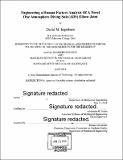| dc.contributor.advisor | Alexandra H. Techet. | en_US |
| dc.contributor.author | Ingraham, David M. (David Michael) | en_US |
| dc.contributor.other | Massachusetts Institute of Technology. Department of Mechanical Engineering. | en_US |
| dc.date.accessioned | 2018-10-22T18:46:20Z | |
| dc.date.available | 2018-10-22T18:46:20Z | |
| dc.date.copyright | 2018 | en_US |
| dc.date.issued | 2018 | en_US |
| dc.identifier.uri | http://hdl.handle.net/1721.1/118720 | |
| dc.description | Thesis: Nav. E., Massachusetts Institute of Technology, Department of Mechanical Engineering, 2018. | en_US |
| dc.description | Thesis: S.M., Massachusetts Institute of Technology, Department of Mechanical Engineering, 2018. | en_US |
| dc.description | Cataloged from PDF version of thesis. | en_US |
| dc.description | Includes bibliographical references (page 81). | en_US |
| dc.description.abstract | An Atmospheric Diving Suit (ADS) is a one person anthropomorphic submersible which is used to facilitate undersea work while keeping the diver/operator at atmospheric pressure thus removing them from the harmful physiological effects associated with diving at depths. Most ADS in use today have limited range of motion/mobility due to the combination of rotary joints utilized. The joint discussed in this thesis differs from rotary joints, widely in use today, in that it is a bellows type joint which allows sixty degrees of motion in plane. The engineering required to allow this joint to operate under pressure is to maintain a constant volume as it travels throughout its range of motion. If volume changes while subjected to pressure from the ocean the joint will seek the position with the smallest volume. Energy would be required to move the joint from the position associated with the smallest volume, making the joint a poor design which could fatigue the operator. This thesis will explain the engineering behind maintaining the volume through a range of motion. Material selection of the joint membrane is a critical component. When designing the joint to maintain constant volume throughout its range of motion an assumption of a perfectly flexible and inelastic material is made. We discuss the ramifications associated with a membrane which is not perfectly inelastic. This thesis continues the work that has been completed in conjunction with a Small Business Technology Transfer (STTR) contract funded by the Office of Naval Research (ONR) between the Massachusetts Institute of Technology and Midé. The elbow joint prototype, developed and manufactured by Midé, was tested in a rig, designed and built at MIT, consisting of a water tank with the joint completely submerged. Range of motion for 15 subjects was captured using image processing software and qualitative interviews were conducted to capture the experience for users with different anthropomorphic measurements. A human factors analysis was performed which proved that the joint operated as designed in a shallow water environment. A prototype ADS consisting of rotary and bellows joints is also proposed. | en_US |
| dc.description.statementofresponsibility | by David M. Ingraham. | en_US |
| dc.format.extent | 81 pages | en_US |
| dc.language.iso | eng | en_US |
| dc.publisher | Massachusetts Institute of Technology | en_US |
| dc.rights | MIT theses are protected by copyright. They may be viewed, downloaded, or printed from this source but further reproduction or distribution in any format is prohibited without written permission. | en_US |
| dc.rights.uri | http://dspace.mit.edu/handle/1721.1/7582 | en_US |
| dc.subject | Mechanical Engineering. | en_US |
| dc.title | Engineering a human Factors analysis of a novel one Atmosphere Diving Suit (ADS) elbow joint | en_US |
| dc.type | Thesis | en_US |
| dc.description.degree | Nav. E. | en_US |
| dc.description.degree | S.M. | en_US |
| dc.contributor.department | Massachusetts Institute of Technology. Department of Mechanical Engineering | |
| dc.identifier.oclc | 1057122009 | en_US |
